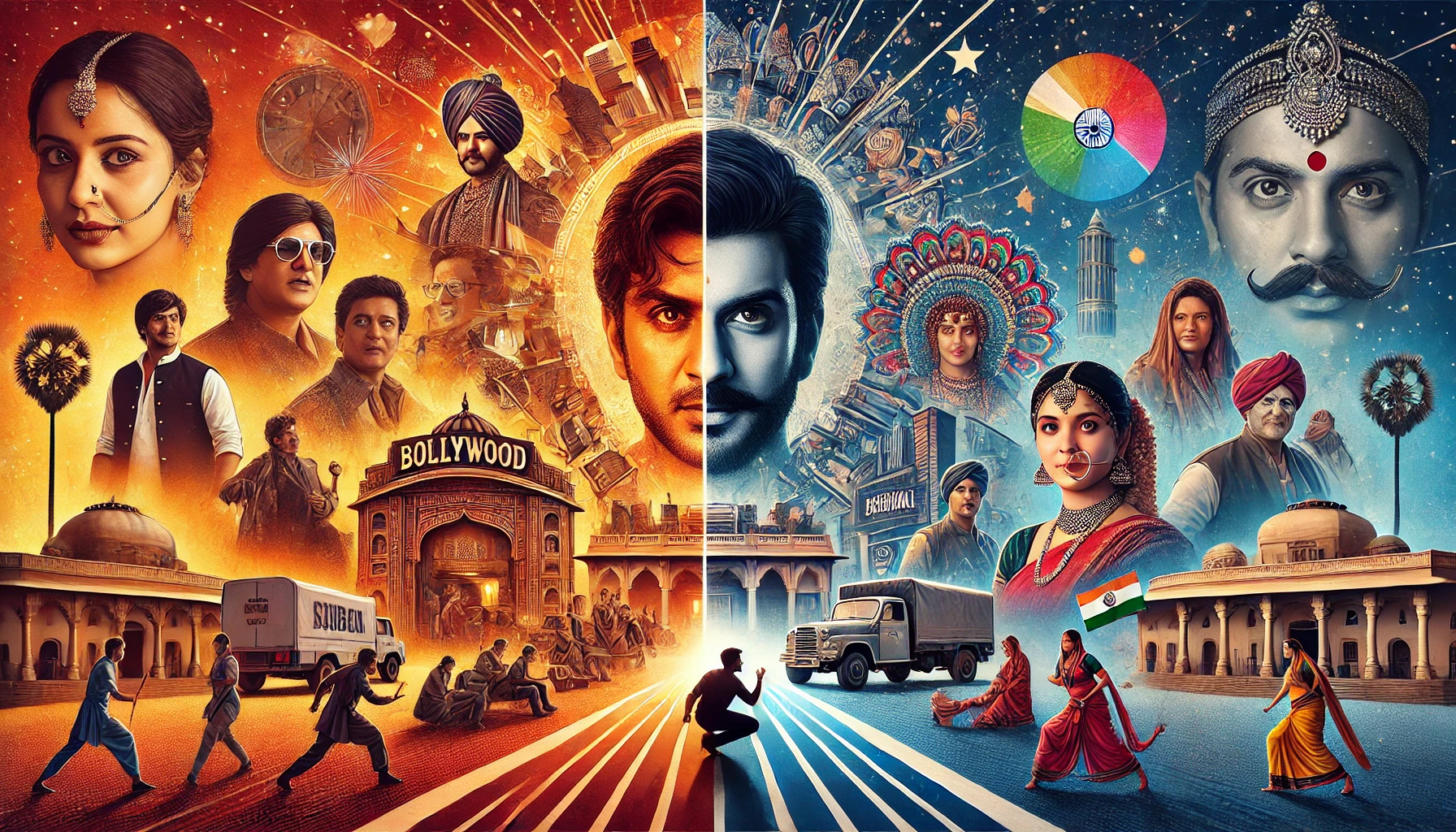Regional cinema in India is taking big strides. It offers fresh ideas, compelling stories, and strong performances. Bollywood can learn a lot from it. From storytelling to technical skills, regional films set new standards. Here’s how Bollywood can take lessons from regional cinema to improve its filmmaking.
1. Strong Storytelling and Character Development
Regional films often focus on deep, layered stories. They explore complex characters and real-life situations. These films are rooted in local cultures, making them feel authentic. Bollywood, on the other hand, tends to stick to the same formulas. This is one area where Bollywood can learn from regional cinema.
Nuanced Narratives
Regional films like Kumbalangi Nights (Malayalam) tell stories in a unique way. They dig deep into human emotions and relationships. Bollywood films often follow a predictable pattern, focusing on love, action, or drama. Regional cinema, however, shows that diverse themes can captivate the audience.
Realism and Authenticity
Films like Masaan (Hindi) and Swaas (Marathi) are rooted in real issues. They show society’s struggles in a true light. In contrast, Bollywood sometimes lacks this level of realism. Authentic portrayals in regional films create a stronger connection with the audience.
Strong Female Characters
Regional films also show women as strong, independent individuals. Films like The Great Indian Kitchen (Malayalam) offer powerful portrayals of women breaking free from societal norms. Bollywood has some strong female roles, but regional films take it a step further, offering more complex characters.
2. Technical Excellence and Visual Innovation
Regional filmmakers are known for their technical skills. They often create beautiful films with smaller budgets. RRR (Telugu) is a great example of top-notch production values. Regional films also experiment with cinematography and editing, pushing the limits of filmmaking.
Innovative Cinematography
Regional cinema explores creative ways to capture visuals. Films like Jallikattu (Malayalam) use dynamic shots to enhance the story. Bollywood, despite its big budgets, often sticks to conventional cinematography. Regional films show that visual storytelling doesn’t always need extravagant sets.
High-Quality Production Values
Despite lower budgets, regional films maintain high production quality. Kantara (Kannada) and Super Deluxe (Tamil) are prime examples. These films have strong production, excellent sound design, and innovative visual effects. Bollywood can take inspiration from this approach of focusing on quality rather than just spectacle.
Technical Mastery
Technical details like editing, sound design, and visual effects are key in regional cinema. Court (Marathi) and Kammattipaadam (Malayalam) show how technical elements can boost the impact of a film. Bollywood should focus more on these aspects to improve its overall filmmaking.
3. Diverse Genres and Experimentation
Regional cinema often explores genres beyond romance and action. It tackles social issues, historical events, and much more. Vada Chennai (Tamil) is a gripping crime drama, while Kumbalangi Nights (Malayalam) offers a subtle take on relationships. Bollywood films often stick to romance, action, and family dramas.
Beyond Romance and Action
Regional films tackle various genres like thrillers, dramas, and social films. Sarbjit (Hindi) deals with cross-border tensions, while Masaan touches on caste issues. Bollywood films often shy away from such bold topics. Regional cinema shows that audiences are open to new ideas.
Bold Themes and Risk-Taking
Films like Super Deluxe (Tamil) tackle controversial topics, including religion, sexual identity, and morality. Regional filmmakers are willing to take risks with stories that Bollywood might avoid. This willingness to tackle bold themes makes regional cinema unique.
Experimenting with Narratives
Regional films are more experimental with their narratives. Piku (Hindi) and Gully Boy (Hindi) were examples of unconventional plots in Bollywood. But regional films go further. They experiment with different storytelling techniques, creating fresh cinematic experiences.
4. Strong Performances and Acting Talent
Regional cinema has some of the best actors in the country. Their performances are often raw and natural. Vijay Sethupathi in 96 (Tamil) and Fahadh Faasil in Thondimuthalum Driksakshiyum (Malayalam) bring depth to their characters. Bollywood often depends on star power, but regional cinema values acting talent above all.
Naturalistic Performances
Actors in regional films give natural performances that make the characters believable. They avoid over-the-top acting and focus on subtle emotions. Bollywood can learn from this approach, as it often leans on larger-than-life performances.
Diverse Talent Pool
In regional cinema, the talent pool is diverse. Actors from different backgrounds, looks, and acting styles bring unique performances. Bollywood often casts actors based on looks or star power. Regional films show that acting talent should be the primary focus.
Conclusion
Regional cinema in India is offering new lessons for Bollywood filmmakers. From deep storytelling to technical brilliance, regional films are setting a new benchmark. Bollywood can learn a lot from the risks regional filmmakers are taking with their narratives, genres, and characters.
The success of films like RRR (Telugu), Masaan (Hindi), and Kumbalangi Nights (Malayalam) shows that there’s an audience for stories that go beyond the mainstream. Bollywood should embrace more authentic, diverse, and bold storytelling. By learning from regional cinema, Bollywood can evolve, create better films, and reach a wider audience.
If you want to learn more about regional cinema and its influence, check out more articles on Films & Minds. For a deeper understanding of how different cultures are shaping Indian cinema, visit Film Companion and The Hindu’s Cinema Section.
Regional cinema’s rise is proof that fresh ideas, diverse stories, and talented actors are the future of filmmaking. It’s time for Bollywood to take these lessons and push the boundaries of storytelling and creativity.










